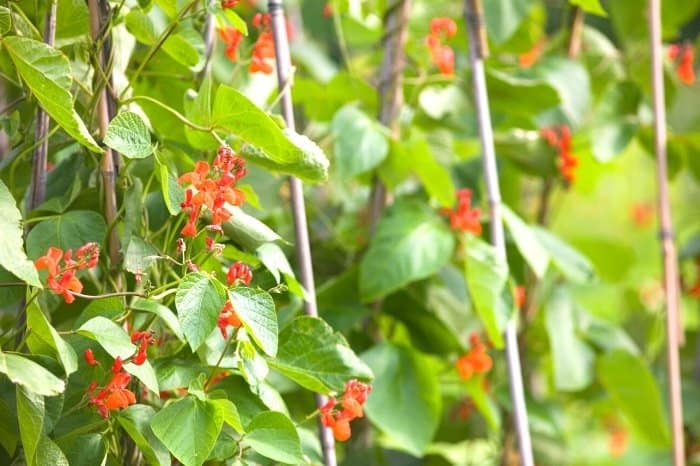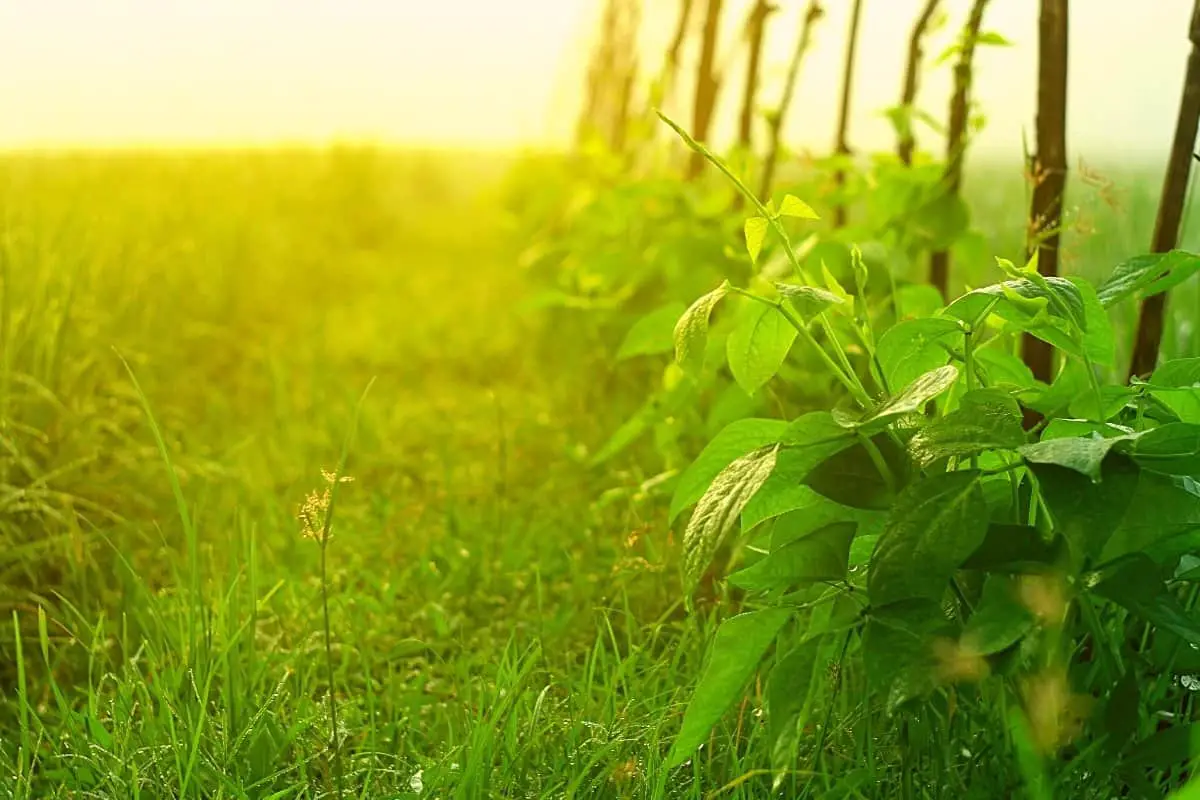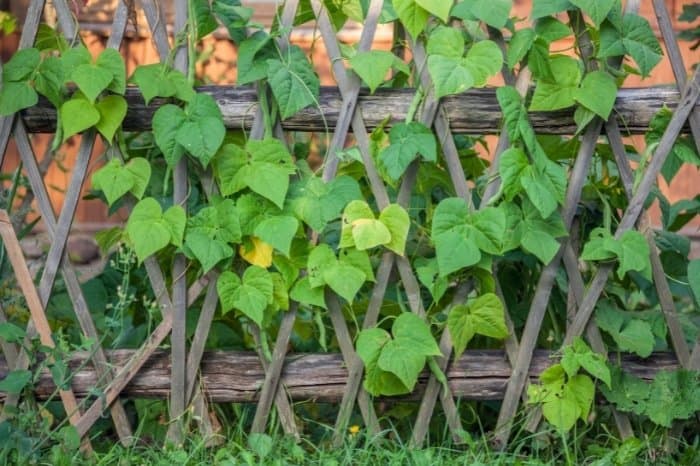Last Updated on March 2, 2023 by Griselda M.
Bean plants are easy to grow, and any gardener can try growing their own. But do you know how long do beans take to grow?
Beans are the second most popular vegetables to grow. They grow fast, providing ready beans to eat within 2 months of planting.
They are available in both bush and vine varieties and require plenty of sun to grow well. Being one of the oldest cultivated vegetables, beans are incredibly adaptable and a staple in many cuisines worldwide.
Green Beans Germination Time
Green beans germination time happens quite quickly if the seeds are properly started. This means that you would need to sow the bean seed in a sterile seed-starting soil mixture to begin. You should also ensure that the soil temperatures are moderate and do not exceed 60 F, as this will flaw the germination process. Additionally, a soggy growing medium or an inadequate amount of water will also contribute to seeds not germinating. However, if all is in order, your green bean seeds will germinate in five to ten days.
Remember that excess water will render the seeds in a dormant state, while too less moisture will expose them to rotting or soil-borne fungal infections, which can be avoided if you follow the correct procedures. Surrounding air temperatures of 65 to 80 F are ideal for green beans as they are warm-weather crops that produce abundant yields in the best-growing conditions.
So How Long Do Bean Plants Grow in Length?
Common beans are either pole beans that grow on long vines or low-growing bush beans. Most of them are green beans, but there are red, purple, streaked, or yellow beans. These beans grow about 2 to 15 ft. tall and 2 to 3 ft. wide, depending on the type of beans.
Beans are best planted in the spring, with their flowers appearing 2 months after planting. Harvest time varies depending on the type of bean but does not exceed 2 months.
Types of Bean Plants You Can Grow
Beans are divided into two classes – bush beans and pole beans.
- Bush Beans grow very fast and may be sown every 3 to 4 weeks from spring to provide a successful harvest in summer. They are excellent for filling gaps and perfect for tubs and window boxes.
- Pole Or Climbing Beans – This type needs a little more space and some form of support to help them climb. This type also bears more beans than the bush type giving you a bumper harvest. These beans are great at adding height to a vegetable garden and make an attractive feature.
Besides these two categories, beans are also categorized by their pods. Green beans have smoother, slender pods, and depending on where you live, you will know them as snap beans, French beans, or string beans.
Runner beans have slightly coarse pods, and they crop a few weeks later than string beans. Some beans love warmer climates, like lima beans and soya beans.
Growing Green Beans
Green beans, also known as snap beans, are tender beans that grow annually starting in spring. They are grown for fresh eating or canning.
Green beans are called so as they are green in color, but other snap beans can be yellow, speckled, or purple, depending on the variety. The yellow ones are sometimes called wax beans.
Green bean pods can vary in size – some are just 3 to 4 inches long while others are 6 to 8 inches long. The pods can either be round or flat.
Sowing
Sow your green beans in the garden after the frost date has passed in spring. If you want to get an early start of the season, sow them indoors as early as 3 to 4 weeks before the last date of the frost date for transplanting in the garden.
Beans grow almost immediately it touches the soil. The pods will be ready for harvest within 2 weeks to a month.
If you want a continuous fresh harvest through the bean-growing season, sow a succession crop every 2 weeks.
Green beans can continue in the garden until the first frost in the fall, but they will not set pods in temperatures over 80 degrees F.
Maintenance And Pest Control
Green beans are very low-maintenance vegetables, and once they grow very well. Keep an eye out for slugs and Mexican beetles that love to infest beans. The Mexican beetles are orange-red pests that have 16 black spots on their backs. Their egg and larvae stages are all yellow and can damage your whole bean garden. To eliminate them, handpick them and destroy them on the spot.
Orange Guard 101 Home Pest Control Gallon
Watering
Beans are also susceptible to fungal infections, so it’s essential to stay out of the bean patch when the weather is wet. Watering can also cause this problem if you are feeding your beans with too much water. Water your green bean plants once a week without rain; pay close attention to irrigation when the plants flower and produce pods. Continuously irrigate early in the morning so that the foliage has a chance to dry out at night.
Mulching
Mulch your bean plants with shredded leaves or straw to reduce weed growth and keep the soil moist.
The Best Place to Grow Green Beans Plants
Green beans thrive in full sun, at least 8 hours of sun or more each day. They will also grow in partial shade, but the harvest is not as full as you would like.
Use well-drained soils, adding rich organic matter for better growth and productivity. Use planting beds if you like, but they are the best to have and add a good amount of old compost.
Avoid planting beans where there is soil nitrogen is high or where green manure crops had just grown. These beans will produce green foliage but few beans. Ensure your soil has a pH of 6.0 to 6.8.

Harvesting Green Beans
Harvest green beans every few days to be able to get more. The more you pick, the more you get, especially when the bean plants peak production.
Excess beans can be blanched, pickled, frozen, or shared with family and friends. Never allow them to overgrow because you have harvested enough; you would instead share with other people than allow your green beans to overgrow.
How Long Do Bean Plants Live?
So, how long do bean plants live? If you’re growing a green bean plant, then the life expectancy will be around one year. These plants are active growers when the temperatures are higher in the spring season and continue to thrive until the colder fall season comes around. Keep in mind that green bean plants have a life cycle that goes through five stages. These include seeding, germination, growth of the leaves, and then flowering.
These stages have a 360 cycle which starts from seed to harvest when seeds become available to continue the process. These growing stages are crucial to understanding, as the timing of each one will give you a better idea of the lifespan of your plant when they stop producing beans.
How Fast Do Bean Plants Grow?
If you’re wondering how fast bean plants grow, then here’s some useful information. Bean plants are known for their rapid growth and abundant harvests if given the proper care and maintenance. If we look at bush beans, these plants produce tender pods in less than two months. You can expect to harvest in about 50 days or so if they are grown healthily.
Pole beans, on the other hand, can take up to 65 days to produce a good harvest, but in some cases, they are ready for picking in just under two months. Staggering your planting every two weeks or so is advised when growing bush beans. This is because these plants usually all come in at once. If you continue harvesting pole beans, you can expect them to produce for about two months.
The fastest-growing varieties are undoubtedly bush beans, according to the University of Arkansas. This is because varieties that include Contender and Topcrop produce ready-to-harvest beans in about 48 days.
How much does a bean plant grow in a week?
How much does a bean plant grow in a week? The estimated growth rate of a bean plant is about 15cm within seven days. These plants are fast growers and take about seven weeks seven weeks to reach their full potential. The growth pattern includes root development and top growth when they’re first started, thereafter leading to the rapid appearance of the entire plant during the growing stages.
You should also remember that transplanting bean plants is not recommended as they prefer to be settled from the beginning. Also, if the soil temperatures are below 60 F, this may contribute to the poor development of your plant. To keep your bean plants thriving week after week, remember to irrigate them immediately after they are planted and ensure that the soil is moist.
Overwatered soil will damage your plant if you are not careful when watering. After your bean plant is established, you should water it as needed for it to continue growing.
How Tall Do Bean Plants Grow?
Seeing that some plants are spread out while others reach for the sky, have you ever given thought to how tall bean plants grow? Let’s take a look at two of the most common bean plants that are widely grown by established and beginner gardeners throughout the US.
Bush bean plant growth:
Bush beans are compact growers that can reach heights of about two feet or so. These plants are quite steady because of their shorter lengths and can grow beautifully with any support structures. So, there’s no need for a trellis when growing these fantastic plants as they stay compact.
Pole bean plant growth:
When growing pole beans, you would have to make use of a support structure as these climbing vines can reach heights of up to 15 feet. For this reason, it is advisable to use a staking or trellis to lend support to your plant so it doesn’t flop over.
Conclusion
Most families have been growing beans for generations – green beans, yellow, and all those kinds of beans.
Green beans have remained a favorite to many families to grow and enjoy throughout the season. They are easy to grow and produce a good harvest to feed families or even share with others.
What are your favorite beans? Baked beans? Fresh beans? Beans stew? or bean soup? Whatever it is, you can enjoy it more if you choose to grow your own.
You have no reason not to try them yourself. You will do great in growing and enjoying them fresh from the garden. Even new gardeners can grow a bumper harvest of beans more than they could ever dream. In addition, you will do just perfectly! We are here to cheer you on!
Caroline is a gardener who loves to get down to the nitty–gritty of gardening. She proudly proclaims herself as a ‘dirt worshipper‘ and can often be found deep in the garden, covered in soil and singing to her plants. As a self–proclaimed ‘plant whisperer‘, Caroline believes that plants need love and attention just like any other living thing, and she loves to give them both. When she‘s not tending to her garden, you can often find her researching the latest gardening trends, or teaching others how to make their gardens thrive




